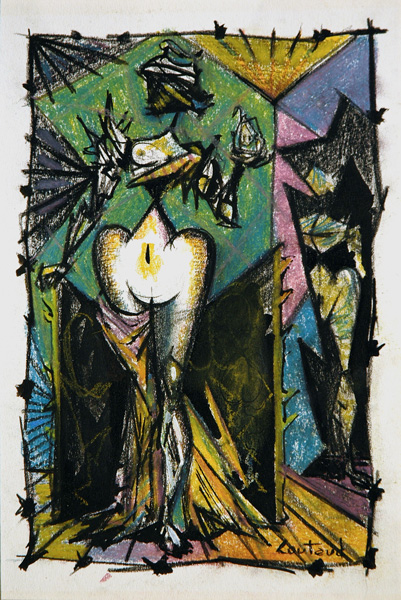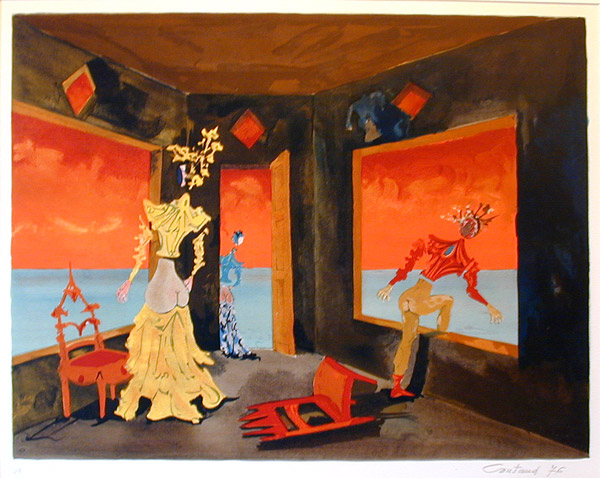|
Although Jean Adhémar (then curator of prints at the Bibliothéque Nationale, Paris), called Coutaud, "the most famous surrealist printmaker (Twentieth-Century Graphics, trans. Eveline Hart [London: Elek, 1971], 217), he remains less known than most of the other important artists associated with the movement. In Europe, however, the situation is quite different. with at least four books devoted to him and to his works. Coutaud was an important figure as a painter (over 1550 paintings), printmaker (more than 150 etchings, engravings, and lithographs), a designer of operas, theatre and ballet sets (17 productions); he contributed illustrations to many books including, most importantly, Gilbert Lély's Ma Civilization (Paris: Editions Maeght, 1947), and painted the cartoons for 29 tapestries. He was a Chevalier in the Legion of Honor, an Officer of the Order of Arts and Letters, and a founding member of the Salon de Mai. He won the Prix National Daumier de la gravure in 1952, the Grand Prix de Peinture de la Ville de Paris in 1967, and the Grand Prix de l'Institut des Beaux Arts in 1971. His work has been shown in galleries and museums in France, Belgium, Switzerland, Sweden, Japan, Italy, and the U.S.
Coutaud's art is frequently involved in depictions of sexuality. Adhémar reminds us that Coutaud "has often said that he cannot conceive of art without eroticism. . . . He sees eroticism in the whole of nature, and asserts that 'nothing looks more like a pair of buttocks than an apricot.' His art, which he himself has dubbed 'erotomagic,' has been fostered by his southern temperment, his admiration for Sade, and his acquaintance with the arcana of the print rooms, But he adds to eroticism an extraordinary feel ing for magic, which puts him in a class of his own" (217, 219). Coutaud's is not easy work; many of his post World War II prints depict life in a ruined landscape and have the ability to stir feelings of discomfort even while they present us with a world in which the erotic is frequently associated with suffering, with voyeurism, with violence. As Adhémar reminds us, "Eroticism is always subversive" (219), and Coutaud is a distinctly subversive artist. In The Artist and the Book in France, (London: Peter Owen, 1969), W. J. Strachan describes Coutaud's etchings as "characterized by an obsessive almost intellectualized eroticism, in which we move in in a kind of half-Freudian, half-Euclidean dream world. He adds, "In the Lély work, as in other later books, he moves equivocally between the world of fantasy and the cruelty of our own times" (p. 102).
Bibliography: Paul Claudel, Theatre France (Paris: Gallimard, 1966). Includes the plays Tete D'Or, Partage De Midi, L'Annonce Faite a Marie, L'Otage, and Le Soulier de Satin; contains 30 beautiful full-color illustrations by Andre Masson, Lucien Coutaud, and Felix Labisse; Jacques Lagarde et al, Retrospective Lucien Coutaud (Paris: Fondation Druout, 1989); Pierre Mazars, Lucien Coutaud, avec une biographie, une bibliographie,et un documentation complète sur le peintre et son oeuvre (Geneva: Editions Pierre Cailler, 1963); W. J. Strachan, The Artist and the Book in France (London: Peter Owen, 1969).
Prints: Pierre Cailler, Catalogue Raisonné de l'Oeuvre Gravé et Lithographié de Lucien Coutaud (Geneva: Editions Pierre Cailler, 1960); Jean-Marie Granier et al, Lucien Coutaud Gravures et Dessins dans les collections des Musée de la Ville de Nîmes (1989).
|
|
|



